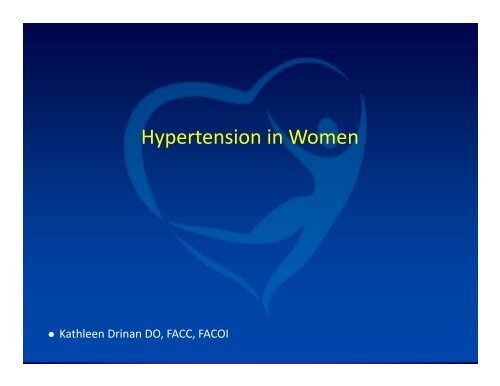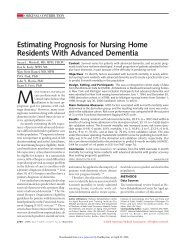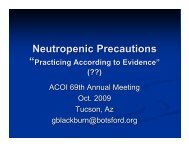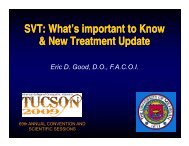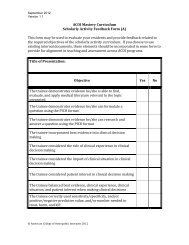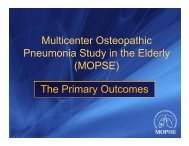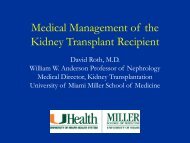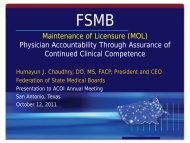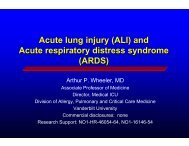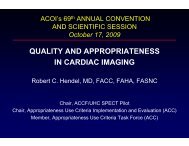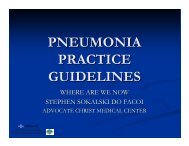Women and Hypertension
Women and Hypertension
Women and Hypertension
- No tags were found...
You also want an ePaper? Increase the reach of your titles
YUMPU automatically turns print PDFs into web optimized ePapers that Google loves.
• Kathleen Drinan DO, FACC, FACOI<strong>Hypertension</strong> in <strong>Women</strong>
<strong>Hypertension</strong> Increases With Age,Faster for <strong>Women</strong>NHANES 1999–2000100Popu ulation, %80604020Males (n=22.3 million)Females (n=35.6 million)020–34 35–44 45–54 55–64 65–74 75+Age, yearsAdapted from American Heart Association. Heart Disease <strong>and</strong> Stroke Statistics—2006 Update. Dallas,TX: American Heart Association; 2006.
Heart Disease Is the Leading Cause of Death in<strong>Women</strong>Actual Cause of Death of U.S. <strong>Women</strong> (2003)De eaths, tho ous<strong>and</strong>s60050040030020010038,74845,058 65,6720Diabetes Alzheimer’s COPD267,902Cancer483,842CVD51% of women cite cancer as their greatest health problem—only 13% cite heart diseaseCVD=cardiovascular disease; COPD=chronic obstructive pulmonary disease.Adapted from American Heart Association. Heart Disease <strong>and</strong> Stroke Statistics—2006 Update. Dallas,TX: American Heart Association; 2006.Mosca L et al. Circulation. 2004;109:573–579.
<strong>Women</strong> <strong>and</strong> <strong>Hypertension</strong>: Perception vs. RealityPERCEPTION: <strong>Women</strong> perceive hypertension as a minor health threat1Top Perceived Threats to <strong>Women</strong>’s Health in the U.S.Total(n=820)Cancer (Net)Breast cancer90%54%Cancer (unspecified)33%Ovarian cancer9%Cervical cancer9%Lung cancer8%Cardiovascular-Related Diseases/Conditions (Net)87%Heart disease (unspecified)/Heart conditions (unspecified) 69%Heart attack16%<strong>Hypertension</strong>, or high BP5%Hypercholesterolemia, or high blood cholesterol1%Diabetes19%Stroke (unspecified)12%Obesity11%Osteoporosis 9%REALITY: 39% of the women surveyed said they have been diagnosedwith hypertension by a physician or other health professionalIn a survey of 820 women >40, only 5% cite hypertension or high BP as one of the top threats towomen’s health.1Harris Interactive. Quick Query Dealing With <strong>Women</strong>’s Top Health Concerns. August 2006;1–3.
Hazard RatioSBP Is a Strong Predictor of CVD EventsAmong Middle-aged <strong>and</strong> Older <strong>Women</strong>The <strong>Women</strong>’s Antioxidant Cardiovascular Study (WACS) 6-YearResults76543210N=5,218RR* of CVD Events According to SBPSBP, mmHg*Adjusted for age, r<strong>and</strong>omization, body mass index, smoking, alcohol use, exercisefrequency, enc diabetes, history of elevated cholesterol, antihypertensive tensi e therapy, priormyocardial infarction, prior stroke, <strong>and</strong> prior revascularization.Mason PJ et al. Circulation. 2004;109:1623–1629.
Post‐MI Risks Are Substantial for <strong>Women</strong>Percent5040302038% of women will diewithin one year post-MIFemalesMales1002 nd HeartAttackSuddenDeathDisabled—Heart FailureStrokeMI=myocardial infarction.Adapted from Thom T et al. Circulation. 2006;113:e85–e151.
<strong>Hypertension</strong> Mortality Is Greater for AfricanAmerican <strong>Women</strong>*Overall Mortality Rates From Causes Related to <strong>Hypertension</strong>Overa all Mortal ityRate, %504030201014.540.80White<strong>Women</strong>African American<strong>Women</strong>*Compared to whites.Adapted from American Heart Association. Heart Disease <strong>and</strong> Stroke Statistics—2006 Update.Dallas, TX: American Heart Association; 2006.
We Are Facing a Heart Failure EpidemicHospital Discharges for HF, 1979–2003:174% IncreaseDischargees in Tho ous<strong>and</strong>s600Females500400Males30020010001979 1983 1987 1991 1995 1999 2003YearAdapted from American Heart Association. Heart Disease <strong>and</strong> Stroke Statistics—2006 Update.Dallas, TX: American Heart Association; 2006.
HF Is A Major Concern for <strong>Women</strong>• 75% of HF cases have antecedent hypertension• At age 40, the lifetime risk of developing HF for women is 1 in 5• 46% of female MI victims will be disabled with HF within 6 years• After HF is diagnosed:• the one year mortality rate is 1 in 5• 70% of women under age 65 will die within 8 years• fewer than 15% of women will survive more than 8−12 yearsAdapted from American Heart Association. Heart Disease <strong>and</strong> Stroke Statistics—2006 Update.Dallas, TX: American Heart Association; 2006.
Some Factors Contributing to g<strong>Hypertension</strong> Among <strong>Women</strong>
BP Rises After Menopause—Risk of <strong>Hypertension</strong> TriplesSBP,Δ FromBaselinemmHgChanges in SBP From Baseline to Follow-up (Mean 5.2 Years)<strong>Women</strong>Controls6Premenopausal5(n=166)4† *Perimenopausal(n=44)3Postmenopausal2(n=105)1–1.9 19 –0.1 0100.4 3.3 3.80.2–1–2–3*P≤0.05.†P=0.07.Baseline SBP: Pre=121.4 ± 13mmHg; 1.3 Peri=122.0 ± 18mmHg; 1.8 Post=126.5 ± 17 1.7mmHg; Controls: men matched by age <strong>and</strong> BMI.Staessen JA et al. J Hum Hypertens. 1997;11:507–514.
Menopause <strong>and</strong> <strong>Hypertension</strong>• Menopause increases incidence of hypertension <strong>and</strong> CV disease• interruption of estrogen—a potent vasodilator—contributes to postmenopausalhypertension• loss of estrogen activates the renin‐angiotensin‐aldosterone system throughupregulation of both ACE activity <strong>and</strong> AT 1 receptors• BP becomes salt‐sensitive after menopause• female sex hormones appear to protect against salt‐induced increases in BPNickenig G et al. Circulation. 1998;97:2197–2201.Oparil S, Miller AP. J Clin Hypertens (Greenwich). 2005;7:300–309.
<strong>Hypertension</strong> Increases With Weight Gain in <strong>Women</strong>Nurses’ Health Study: <strong>Hypertension</strong> † According to Weight ChangeMultivar riate RR*7 Age
Smoking <strong>and</strong> Physical Inactivity Are Risk Factors forCardiovascular Disease• Smoking has been associated with 50% of all coronary events inwomen• Coronary risk is elevated even in women with minimal use(relative risk ik24f 2.4 for 1–4 cigarettes/day)• 66% of women reported never engaging in vigorous physicalactivity lasting ≥10 minutes per week• Another 12% reported minimal (
Smoking <strong>and</strong> Physical Inactivity Are Risk Factors forCardiovascular Disease• Smoking has been associated with 50% of all coronary events inwomen• Coronary risk is elevated even in women with minimal use(relative risk ik24f 2.4 for 1–4 cigarettes/day)• 66% of women reported never engaging in vigorous physicalactivity lasting ≥10 minutes per week• Another 12% reported minimal (
<strong>Hypertension</strong> Control<strong>Hypertension</strong> ControlAmong <strong>Women</strong>
Evolution of Antihypertensive Agents1950s1960s1970s1980s1990sVasodilatorsCentral 2 -agonistsAldosterone receptor blockersDiureticsβ-adrenergic blockersCalcium channel blockers (nondihydropyridines) 1 -blockers- β-blockersCalcium channel blockers (dihydropyridines)Angiotensin-converting i ienzyme inhibitorsAngiotensin receptor blockersScholz H. Z Kardiol. 2002;91:34−42.
Control of <strong>Hypertension</strong> Low in <strong>Women</strong>About Half Are Treated; About a Quarter Are Controlled*olled*<strong>Women</strong> n, %8070605040302010075.1 73.671.260.160.062.029.127.429.61988–1991 1991–1994 1999–2000Awareness Treatment Control*Percentage of hypertensive patients controlled. Control=treatment with antihypertensivemedication <strong>and</strong> a measured BP of
Today, we have:increased knowledge about the prevalence of hypertension amongwomena better underst<strong>and</strong>ing of CV risks in womenmore aggressive hypertension treatment guidelinesmore effective drug optionsSo why are BP control rates among women as lowas they were nearly 20 years ago?
Why Are So Many <strong>Women</strong> Unaware ofTheir <strong>Hypertension</strong>?• <strong>Hypertension</strong> rarely causes noticeable symptoms —recognizedas “the silent killer”• Usually detected during routine physical examThe <strong>Women</strong> Take Heart ProjectUnacknowledged or unaware hypertensive women weresignificantly ifi younger as a group, had a lower mean BMI, <strong>and</strong> alower waist-toto-hip ratio than women who reported a history ofhypertension.However, their BP measures were similar:ilunaware hypertensive women (146/89 mmHg) vs.aware hypertensive women (147/88 mmHg).http://www. johnshopkinshealthalerts.com/reports/heart_health/136-1. html. Accessed August 10, 2006.Furumoto-Dawson AA et al. J Clin Hypertens. 2003;5:38−46.
AWARENESS• WTH – over one half of the hypertensive women were either undiagnosedor unaware or did not acknowledge their hypertension.
• “I walked into my doctor’s office complaining of heart palpitations My• I walked into my doctor s office complaining of heart palpitations. Myblood pressure was 180/90.”
• “My doctor gave me a grave look <strong>and</strong> said,• “you need to lose weight”.• “Tell me something I don’t know”, I thought smugly. I didn’t take heradvice seriously. After all, I’d been heavier <strong>and</strong> never felt my heart racing.“I’d had perfect blood pressure – 110/70 for years, even at my heaviest.
Blood Pressure Patternsin the General Population (NHANES III)Men<strong>Women</strong>150150130110SBPPP130110SBPPP808070DBP70DBP30-3939 40-4949 50-5959 60-6969 70-7979 80Age30-3939 40-4949 50-5959 60-6969 70-7979 80AgeAdapted from Burt VL et al. <strong>Hypertension</strong> 1995;25:305-313. 313.
JNC 7*:Need for Prompt Aggressive Action• Current control rates unacceptable• Most patients can achieve goal (the majoritywill require >2 drugs)• Adjust therapy monthly or more frequentlyuntil goal is reached“Action to control BP is needed now <strong>and</strong> isa challenge that all must accept.”—Kottke T et al. JAMA. 2003*JNC 7=The Seventh Report on the Joint National Committee on Prevention, Detection,Evaluation, <strong>and</strong> Treatment of High Blood Pressure.Chobanian AV et al. <strong>Hypertension</strong>. 2003;42:1206–1252.Kottke T et al. JAMA. 2003;289:2573–2575.
Aggressively Lowering BPPrevents Clinical i l EventsRe eduction in BP, mm mHgEach 5 mmHg reductionin DBP reduces*0–1 Stroke by 34%–2Ischemic heartdisease by 21%–3–4–5–6–7IMPORTANT NOTE: The medicinesdiscussed are approved to treat high–8BP <strong>and</strong> are not approved to prevent–9ischemic heart disease or stroke–10resulting from high BP.Each 10 mmHg reductionin DBP reduces*Stroke by 56%Ischemic heartdisease by 38%*From any pretreatment level; no threshold. Estimated from 9 large cohort studies.Law M et al. Health Technol Assess. 2003;7:1–94.
JNC 7: Management of BPLifestyle Modification: JNC 7 encourages lifestyle modification for patients whohave normal BP, <strong>and</strong> recommends lifestyle modification for patients who areprehypertensive, or are stage 1 or stage 2 hypertensive.Normal
PREVENTIONThe prevalence of hypertension is very lowin women


